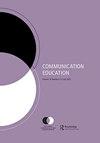Healing the disciplinary divide between communication and English to secure the future of communication education: a response to forum essays
IF 0.8
Q3 COMMUNICATION
引用次数: 0
Abstract
In 2014, the year of the centennial celebration of the National Communication Association (NCA), I (Cheri) facilitated a series of workshops for introductory communication course directors. At one of the workshops, a participant came up to me to ask for advice. He indicated that while he was the coordinator for the introductory communication course, he was housed in a department of English, had no hiring or supervisory authority, and did not have access to train his instructors (most of whom held degrees in English). And while I am not confident that my advice was of any help, I did try to let him know the circumstances were beyond his control. I related to him that as a first-year faculty member in the department of English, he was not in a position to fight a 100-year battle. For it was in 1914 that a group of speech teachers feeling isolated from the National Council of Teachers of English decided to form their own organization, specific to the teaching of speech communication (Braithwaite, 2014). Thus, the National Association of Academic Teachers of Public Speaking (now NCA) was founded. While we gain our disciplinary roots as teachers of public speaking, the interdisciplinary animosity lingers. This culture of isolation between communication and English was amplified by national educational reforms and the advent of the No Child Left Behind Act of 2001 (U.S. Public Law 107–110, 2002). Jennings (2010) highlighted how these mandates created unique challenges for the field of communication education. Jennings noted that as states and teacher-preparation programs moved to meet the requirements of NCLB, many states decided to reduce the number of certification programs by combining similar subject areas. As a result, communication education was subsumed with English Language Arts (ELA). Little did these lawmakers realize that, in essence, they were forcing two “divorced” disciplines to “get back together.” This forced reunion has yielded scant cooperation between English and communication education teacherpreparation programs. As a result of this combined certification, communication education programs were ultimately edged out of ELA as English education programs were not required to offer communication instruction. With the passage of the Common Core State Standards (CCSS) in 2010, ELA incorporated speaking, listening, and media literacy into the curriculum. Many in communication education were hopeful that the CCSS would revolutionize and renew the value of弥合沟通与英语之间的学科鸿沟,确保沟通教育的未来:对论坛文章的回应
2014年是美国传播协会(NCA)成立一百周年,我(Cheri)为传播学入门课程主任举办了一系列研讨会。在其中一次研讨会上,一位参与者向我寻求建议。他表示,虽然他是介绍性沟通课程的协调员,但他被安置在英语系,没有招聘或监督权力,也没有机会培训他的讲师(他们中的大多数都拥有英语学位)。虽然我不相信我的建议有任何帮助,但我确实试图让他知道,情况超出了他的控制范围。我告诉他,作为英语系的一年级教员,他没有能力打一场百年之战。因为正是在1914年,一群感到被国家英语教师委员会孤立的语言教师决定组建自己的组织,专门从事语言交际教学(Braithwaite, 2014)。因此,全国公共演讲学术教师协会(现在的NCA)成立了。虽然我们作为公共演讲教师获得了学科基础,但跨学科的敌意仍然存在。国家教育改革和2001年《不让一个孩子掉队法》(2002年美国公法107-110)的出台扩大了这种交流和英语之间的隔离文化。詹宁斯(2010)强调了这些规定如何给传播教育领域带来独特的挑战。詹宁斯指出,随着各州和教师培训项目为满足《反不歧视法》的要求而采取行动,许多州决定通过合并类似的学科领域来减少认证项目的数量。因此,交际教育被归入英语语言艺术(ELA)。这些立法者几乎没有意识到,从本质上讲,他们是在迫使两个“离婚”的学科“重归于好”。这种被迫的重聚使得英语和交际教育教师培训项目之间的合作不足。由于这一联合认证,沟通教育课程最终被挤出了ELA,因为英语教育课程不需要提供沟通教学。随着2010年共同核心州标准(CCSS)的通过,ELA将口语,听力和媒体素养纳入课程。许多传播教育界人士都希望CCSS能够彻底改变和更新传播教育的价值
本文章由计算机程序翻译,如有差异,请以英文原文为准。
求助全文
约1分钟内获得全文
求助全文
来源期刊

COMMUNICATION EDUCATION
EDUCATION & EDUCATIONAL RESEARCH-
CiteScore
3.10
自引率
34.80%
发文量
47
期刊介绍:
Communication Education is a peer-reviewed publication of the National Communication Association. Communication Education publishes original scholarship that advances understanding of the role of communication in the teaching and learning process in diverse spaces, structures, and interactions, within and outside of academia. Communication Education welcomes scholarship from diverse perspectives and methodologies, including quantitative, qualitative, and critical/textual approaches. All submissions must be methodologically rigorous and theoretically grounded and geared toward advancing knowledge production in communication, teaching, and learning. Scholarship in Communication Education addresses the intersections of communication, teaching, and learning related to topics and contexts that include but are not limited to: • student/teacher relationships • student/teacher characteristics • student/teacher identity construction • student learning outcomes • student engagement • diversity, inclusion, and difference • social justice • instructional technology/social media • the basic communication course • service learning • communication across the curriculum • communication instruction in business and the professions • communication instruction in civic arenas In addition to articles, the journal will publish occasional scholarly exchanges on topics related to communication, teaching, and learning, such as: • Analytic review articles: agenda-setting pieces including examinations of key questions about the field • Forum essays: themed pieces for dialogue or debate on current communication, teaching, and learning issues
 求助内容:
求助内容: 应助结果提醒方式:
应助结果提醒方式:


